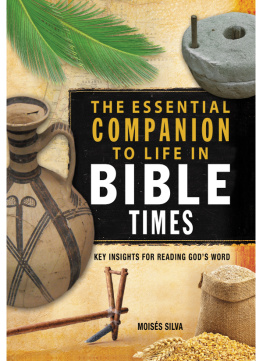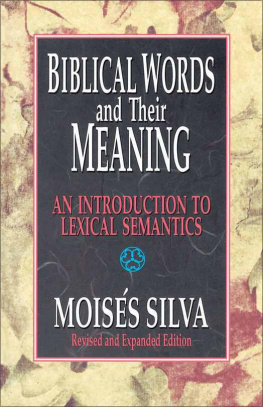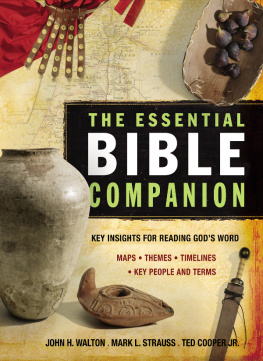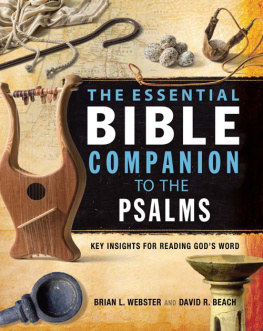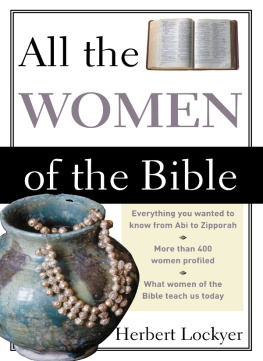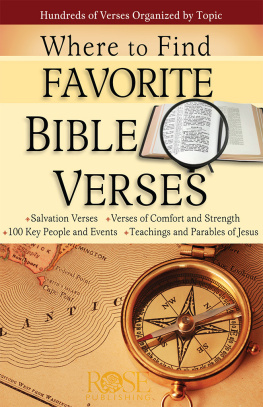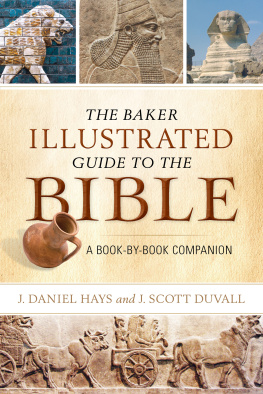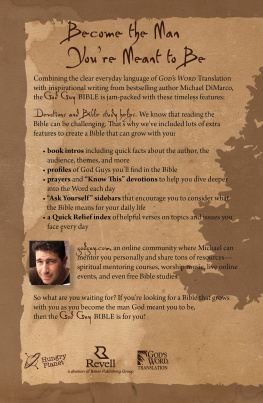Essential Bible Companion Series
Essential Bible Atlas
Essential Bible Companion
Essential Bible Companion to the Psalms
Essential Bible Dictionary
Essential Companion to Life in Bible Times
ZONDERVAN
The Essential Companion to Life in Bible Times
Copyright 2011 by Moiss Silva
Requests for information should be addressed to:
Zondervan, Grand Rapids, Michigan 49530
ePub Edition September 2016: ISBN 978-0-310-53544-7
Library of Congress Cataloging-in-Publication Data
Silva, Moiss
The essential companion to life in Bible times / Moiss Silva.
p. cm. (Essential Bible companion series)
ISBN 978-0-310-28688-2 (softcover)
1. Jews Social life and customs To 70 A.D. 2. Jews Antiquities. 3. Bible. O.T. Criticism, interpretation, etc. 4. Bible. N.T. Criticism, interpretation, etc. I. Title.
DS112.S488 2011
220.9'5 dc22
2010034655
All Scripture quotations, unless otherwise indicated, are taken from the Holy Bible, New International Version, NIV. Copyright 1973, 1978, 1984 by Biblica, Inc. Used by permission of Zondervan. All rights reserved worldwide.
Scripture quotations marked TNIV are taken from the Holy Bible, Todays New International Version. TNIV. Copyright 2001, 2005 by Biblica, Inc. Used by permission of Zondervan. All rights reserved worldwide.
The Scripture quotations marked NRSV are taken from the New Revised Standard Version of the Bible, Copyright 1989 by the Division of Christian Education of the National Council of Churches of Christ in the United States of America, and are used by permission. All rights reserved.
Scripture quotations marked NASB are taken from the New American Standard Bible, Copyright 1960, 1962, 1963, 1968, 1971, 1972, 1973, 1975, 1977, 1995 by The Lockman Foundation. Used by permission.
Maps by International Mapping. Copyright 2011 by Zondervan. All rights reserved.
Any Internet addresses (websites, blogs, etc.) and telephone numbers printed in this book are offered as a resource. These are not intended in any way to be or imply an endorsement by Zondervan, nor does Zondervan vouch for the content of these sites and numbers for the life of this book.
All rights reserved. No part of this publication may be reproduced, stored in a retrieval system, or transmitted in any form or by any means electronic, mechanical, photocopy, recording, or any other except for brief quotations in printed reviews, without the prior permission of the publisher.
Cover design: Kirk Douponce, DogEaredDesign.com
Art Direction: Tammy Johnson
Cover photography: Steve Gardner/Pixelworks Studio; Erich Lessing/Art Resource,
NY; Kim Walton/Walton Images; Steve Gorton/Dorling Kindersley
Interior design: Matthew VanZomeren
11 12 13 14 15 16 17 18 19 /CTC/ 23 22 21 20 19 18 17 16 15 14 13 12 11 10 9 8 7 6 5 4 3 2 1
Contents
T he central message of the Bible is clear to any reader. No great education is needed to understand the truths of the gospel and what God requires of us.
Those who wish to dig deeper, however, find it especially helpful to gain some knowledge of the cultural context in which the Bible was written. Information about its historical setting and about ancient customs can shed wonderful light on the text of Scripture.
Extensive and detailed information of this type can be found in the five-volume Zondervan Encyclopedia of the Bible and, more briefly, in the one-volume Zondervan Illustrated Bible Dictionary. But because the material in those reference works is organized alphabetically, readers who wish to obtain knowledge of broad subjects need to consult a wide variety of separate articles and to integrate the data into a coherent whole.
The content of the present book is derived from those two works, but the material is reorganized on a topical basis. Moreover, the text has at times been revised and adapted so that it becomes more useful in its new setting.
It is our hope that many Bible students will be encouraged and helped by this new presentation.
| AD | Anno Domini (Year of our Lord) |
| BC | Before Christ |
| c. | circa (about, approximately) |
| cf. | confer (compare) |
| e.g. | exempli gratia (for example) |
| et al. | et alii (and others) |
| ft. | feet |
| i.e. | id est (that is) |
| in. | inches |
| KJV | King James Version |
| NASB | New American Standard Bible |
| NIV | New International Version (1984 ed.) |
| NRSV | New Revised Standard Version |
| NT | New Testament |
| OT | Old Testament |
| TNIV | Todays New International Version |
A s the fundamental unit of human society, the family played a central role in Israelite history and culture. This chapter explores the role of individuals in family life from birth until death.
As in other cultures, so also in Israel the birth of a child was a very joyful occasion (Lk. 1:57 58). Moreover, having many children was seen as a special blessing from God:
Sons are a heritage from the L ORD ,
children a reward from him.
Like arrows in the hands of a warrior
are sons born in ones youth.
Blessed is the man
whose quiver is full of them.
They will not be put to shame
when they contend with their
enemies in the gate. (Ps. 127:3 5)
Conversely, to be a wife without motherhood was regarded not merely as a matter of regret, but also of reproach and humiliation, as may be seen from Rachels passionate words to her husband Jacob, Give me children, or Ill die! (Gen. 30:1), and from Hannahs silent pleading (1 Sam. 1:10 17). It is significant that the wives of the Hebrew patriarchs Sarah, Rebekah, Rachel (but not Leah) were by nature barren (Gen. 11:30; 25:21; 29:31), and therefore Gods special intervention in their lives showed his favor to Israel (cf. also Elizabeth, Lk. 1:5 25).
According to the Hebrew ceremonial system, childbirth rendered a mother unclean because of the bleeding involved (Lev. 12:1 5). After the period of purification was over, she was to bring to the priest a lamb and a pigeon (or dove) to be sacrificed. If she could not afford a lamb, she was allowed to offer a second pigeon instead (12:6 8). The fact that Mary offered two pigeons after the birth of Jesus gives touching testimony to the familys comparative poverty (Lk. 2:22 24).
In the case of a boy, circumcision the cutting off of his foreskin was to be performed on the eighth day (Lev. 12:3), at which time the child was officially given his name (Lk. 1:59). Although circumcision was practiced in Egypt and elsewhere, this ritual was especially significant among the Hebrews, for it gave witness to the unique covenant that God had established with Abraham, the father of the nation (Gen. 17:9 14). According to the terms of the covenant, the Lord undertook to be the God of Abraham and his descendants, and they were to belong to him, worshipping and obeying only him. Circumcision reminded the Israelites of Gods promises to them and of the duties they had assumed.
The Bible emphasizes that the outward rite, to have any significance, must be accompanied by a circumcision of the heart (cf. Lev. 26:41; Deut. 30:6; Ezek. 44:7). Faithless Israelites were no better than the pagans, for they were uncircumcised in heart (Jer. 9:25 26; cf. Rom. 2:25 29). In the early history of the Christian church, some Jewish Christians argued for the necessity of circumcising Gentiles who came into the church (Acts 15:1 5). Paul, however, insisted that the signs of the old covenant should not be forced on the children of the new covenant (Gal. 2:3 5; 5:1 6). Pauls view was affirmed by the Council of Jerusalem (Acts 15:22 29).

